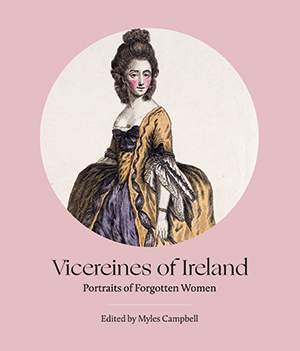VICEREINES OF IRELAND: PORTRAITS OF FORGOTTEN WOMEN
Published in Book Reviews, Book Reviews, Issue 1 (January/February 2022), Reviews, Volume 30 MYLES CAMPBELL (ed.)
MYLES CAMPBELL (ed.)
Irish Academic Press
€45
ISSN 9781788551355
Reviewed by Sylvie Kleinman
Sylvie Kleinman is Visiting Research Fellow at the Department of History, Trinity College, Dublin.
When Mary Robinson addressed us at her inauguration in St Patrick’s Hall, Dublin Castle, in 1990, she voiced the wish to see women who had felt outside of history written back into it. This transformational moment, which bound us to that gilded former ballroom which otherwise left many of us lukewarm, heralded societal changes that impacted on historical enquiry. Evidently she had meant how women of all backgrounds had just rewritten the history of their own times, yet Myles Campbell opens this book by reflecting on her words. With them he leads into this study of seven of the élite women who had also stood in that hall, albeit in a supporting role as the wives and consorts of the viceroys of Ireland. The agency of these so-called ‘women worthies’ of the past remains mostly buried in their husband’s biographies or academic studies. The much-maligned Lady Aberdeen still elicits cringing in some quarters, despite an unquestionable track record in female empowerment and mobilisation at international level, in her case channelling leadership skills to improve public health in Ireland. A Liberal and Home Ruler, she was as politicised as the conservative Unionist Lady Londonderry. Both were on the cusp of an era when women could, and would, enter politics but, being high-born and of their generation, were precluded from it. The vicereines surveyed here were often self-aware and reflected on how their gender limited their agency, yet some used their power to vigorously push the boundaries. In 1801 Elizabeth, Countess of Hardwicke, recorded her position: relegated to a side gallery of the chapel, she did not represent the queen, though her prominently positioned spouse represented the king.
This book of fluidly written essays is richly illustrated and doubles as the catalogue to an exhibition (in Dublin Castle, Aug.–Sept. 2021) but, beyond the shimmering fabrics and glinting pearls, the collective effort portrays aspects of the social, cultural, charitable and even political activities of these women. They range from 1661 and the first Duchess of Ormonde’s arrival to the 1938 visit by Lady Aberdeen to the Peamount Hospital and Industries, which had grown out of the tuberculosis sanitorium that she had been instrumental in establishing in 1912. Emanating out of the OPW itself, the project needs no justification, and Campbell’s informative introductory survey of how the role of vicereine was played out over time fills an important gap.
This fly-through cannot do justice to either the authors or their subjects, and each chapter is enlightening on the Ireland of the day and on élite female spheres of influence. The vicereine was the pre-eminent influencer and society hostess during her husband’s tour of duty, but networking beyond the Castle gate was highly politicised. High expectations and exertions to please also had an impact on their domestic sphere, and even on personal health. Some fine examples of astuteness and networking strategies fly off the pages. Previously on the wrong side of history, the shrewd Catholic and Jacobite Duchess of Tyrconnel is contextualised in a fine portrayal of early modern womanhood. Often the de facto patroness, or even instigator, of key charities, the vicereine was far from invisible to the general public, at times well known to the Liberties weaver. Heading fund-raisers, she doubled as a patroness of the arts, and the connected musical, theatrical and artistic events supported many professions. In the eighteenth century she also became the demonstrable champion of distressed artisans and manufacturers, and famously promoted various textile industries. Showcasing the finest Irish silk or linen by being seen wearing it in public was heavily chatted about, as was ordering and commissioning oodles of furniture and tapestries for the Castle. The talented Lady Mulgrave not only promoted Irish poplin but also designed motifs, and her efforts led to Queen Victoria wearing a fine brocaded sample festooned with shamrock. Then came the renowned support of the lace and cottage industries, which also openly supported female labour and thus some form of individual autonomy. The sphere of influence of the vicereine was not confined to Dublin; while some were generally detached, even apathetic, others were deeply conscious of deprivation both urban and rural, and addressed (not always successfully) the inadequacy of measures even as state institutions were evolving.
This work is described at the outset as necessarily selective, and further research is needed on both individuals and broader contextual themes. One example is the absence of Rachel, Lady Dudley (1902–5), the daughter of a Norfolk banker and not an aristocrat by birth, who had helped establish a district nursing scheme in the West, named after her. All chapters tightly embed biographies within the context of the day, and some vicereines did not break their connection to Ireland when tours of duty ended. There are some exceptional, personable portraits by eminent artists, but the narrative consciously eschews the patronising physical description ‘methodology’ of the past, building character profiles through perusal of available sources. This may explain why the cover illustration is the least compelling portrait, apart from the least artistically accomplished. The coffee-table version of the book is reasonably priced but unwieldy, while a softback or e-version can prove a valuable resource for students. Decades after Robinson’s election, the thirst for knowledge has overtaken the past’s unbalanced and male-dominated approaches to history, though when approaching the realm of the lavish viceregal court one must not underestimate the value of the ‘Diana’ effect.
















